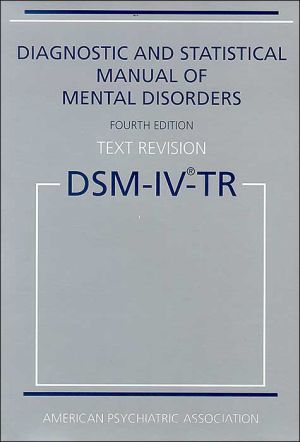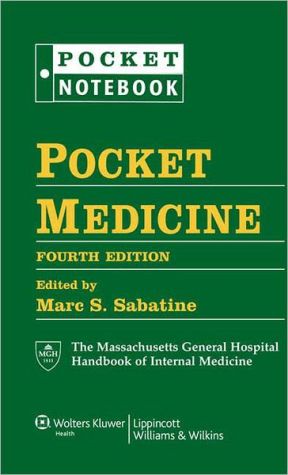Diagnostic and Statistical Manual of Mental Disorders, Fourth Edition, Text Revision (DSM-IV-TR)
Since the DSM-IV® was published in 1994, we've seen many advances in our knowledge of psychiatric illness. This Text Revision incorporates information culled from a comprehensive literature review of research about mental disorders published since DSM-IV® was completed in 1994. Updated information is included about the associated features, culture, age, and gender features, prevalence, course, and familial pattern of mental disorders.\ The DSM-IV-TR® brings this essential diagnostic tool...
Search in google:
Since the DSM-IV® was published in 1994, we’ve seen many advances in our knowledge of psychiatric illness. This Text Revision incorporates information culled from a comprehensive literature review of research about mental disorders published since DSM-IV® was completed in 1994. Updated information is included about the associated features, culture, age, and gender features, prevalence, course, and familial pattern of mental disorders. The DSM-IV-TR® brings this essential diagnostic tool up-to-date, to promote effective diagnosis, treatment, and quality of care. Now you can get all the essential diagnostic information you rely on from the DSM-IV® along with important updates not found in the 1994 edition.Stay current with important updates to the DSM-IV-TR®: • Benefit from new research into Schizophrenia, Asperger’s Disorder, and other conditions• Utilize additional information about the epidemiology and other facets of DSM conditions• Update ICD-9-CM codes implemented since 1994 (including Conduct Disorder, Dementia, Somatoform Disorders)
Multiaxial Assessment\ A multiaxial system involves an assessment on several axes, each of which refers to a different domain of information that may help the clinician plan treatment and predict outcome. There are five axes included in the DSM-IV multiaxial classification: \ Axis I Clinical Disorders\ Other Conditions That May Be a Focus of Clinical Attention\ Axis II Personality Disorders\ Mental Retardation\ Axis III General Medical Conditions\ Axis IV Psychosocial and Environmental Problems\ Axis V Global Assessment of Functioning\ \ The use of the multiaxial system facilitates comprehensive and systematic evaluation with attention to the various mental disorders and general medical conditions, psychosocial and environmental problems, and level of functioning that might be overlooked if the focus were on assessing a single presenting problem. A multiaxial system provides a convenient format for organizing and communicating clinical information, for capturing the complexity of clinical situations, and for describing the heterogeneity of individuals presenting with the same diagnosis. In addition, the multiaxial system promotes the application of the biopsychosocial model in clinical, educational, and research settings.\ The rest of this section provides a description of each of the DSM-IV axes. In some settings or situations, clinicians may prefer not to use the multiaxial system. For this reason, guidelines for reporting the results of a DSM-IV assessment without applying the formal multiaxial system areprovided at the end of this section.\ Axis I: Clinical Disorders\ Other Conditions That May Be a Focus of Clinical Attention\ Axis I is for reporting all the various disorders or conditions in the Classification except for the Personality Disorders and Mental Retardation (which are reported on Axis II). The major groups of disorders to be reported on Axis I are listed in the box below. Also reported on Axis I are Other Conditions That May Be a Focus of Clinical Attention.\ When an individual has more than one Axis I disorder, all of these should be reported (for examples, see p. 35). If more than one Axis I disorder is present, the principal diagnosis or the reason for visit (see p. 3) should be indicated by listing it first. When an individual has both an Axis I and an Axis 11 disorder, the principal diagnosis or the reason for visit will be assumed to be on Axis I unless the Axis 11 diagnosis is followed by the qualifying phrase "(Principal Diagnosis)" or "(Reason for Visit)." If no Axis I disorder is present, this should be coded as V71.09. If an Axis I diagnosis is deferred, pending the gathering of additional information, this should be coded as 799.9.\ Axis II: Personality Disorders\ Mental Retardation\ Axis 11 is for reporting Personality Disorders and Mental Retardation. It may also be used for noting prominent maladaptive personality features and defense mechanisms. The listing of Personality Disorders and Mental Retardation on a separate axis ensures that consideration will be given to the possible presence of Personality Disorders and Mental Retardation that might otherwise be overlooked when attention is directed to the usually more florid Axis I disorders. The coding of Personality Disorders on Axis II should not be taken to imply that their pathogenesis or range of appropriate treatment is fundamentally different from that for the disorders coded on Axis I. The disorders to be reported on Axis II are listed in the box below.\ In the common situation in which an individual has more than one Axis 11 diagnosis, all should be reported (for examples, see p. 35). When an individual has both an Axis I and an Axis II diagnosis and the Axis II diagnosis is the principal diagnosis or the reason for visit, this should be indicated by adding the qualifying phrase 'Principal Diagnosis)" or "(Reason for Visit)" after the Axis II diagnosis. If no Axis II disorder is present, this should be coded as V71.09. If an Axis II diagnosis is deferred, pending the gathering of additional information, this should be coded as 799.9.\ Axis lI may also be used to indicate prominent maladaptive personality features that do not meet the threshold for a Personality Disorder (in such instances, no code number should be used-see Example 3 on p. 37). The habitual use of maladaptive defense mechanisms may also be indicated on Axis II (see Appendix B, p. 811, for definitions and Example 1 on p. 37).\ Axis III: General Medical Conditions\ Axis III is for reporting current general medical conditions that are potentially relevant to the understanding or management of the individual's mental disorder. These conditions are classified outside the "Mental Disorders" chapter of ICD-9-CM (and outside Chapter V of ICD-10). A listing of the broad categories of general medical conditions is given in the box below. (For a more detailed listing including the specific ICD-9-CM codes, refer to Appendix G.)\ As discussed in the "Introduction," the multiaxial distinction among Axis I, Axis Il, and Axis III disorders does not imply that there are fundamental differences in their conceptualization, that mental disorders are unrelated to physical or biological factors or processes, or that general medical conditions are unrelated to behavioral or psychosocial factors or processes. The purpose of distinguishing general medical conditions is to encourage thoroughness in evaluation and to enhance communication among health care providers.\ General medical conditions can be related to mental disorders in a variety of ways. In some cases it is clear that the general medical condition is directly etiological to the development or worsening of mental symptoms and that the mechanism for this effect is physiological. When a mental disorder is judged to be a direct physiological consequence of the general medical condition, a Mental Disorder Due to a General Medical Condition should be diagnosed on Axis I and the general medical condition should be recorded on both Axis I and Axis III. For example, when hypothyroidism is a direct cause of depressive symptoms, the designation on Axis I is 293.83 Mood Disorder Due to Hypothyroidism, With Depressive Features, and the hypothyroidism is listed again and coded on Axis III as 244.9 (see Example 3, p. 37).\ In those instances in which the etiological relationship between the general medical condition and the mental symptoms is insufficiently clear to warrant an Axis I diagnosis of Mental Disorder Due to a General Medical Condition, the appropriate mental disorder (e.g., Major Depressive Disorder) should be listed and coded on Axis I; the general medical condition should only be coded on Axis III.\ There are other situations in which general medical conditions are recorded on Axis III because of their importance to the overall understanding or treatment of the individual with the mental disorder. An Axis I disorder may be a psychological reaction to an Axis III general medical condition (e.g., the development of 309.0 Adjustment Disorder With Depressed Mood as a reaction to the diagnosis of carcinoma of the breast). Some general medical conditions may not be directly related to the mental disorder but nonetheless have important prognostic or treatment implications (e.g., when the diagnosis on Axis I is 296.30 Major Depressive Disorder, Recurrent, and on Axis III is 427.9 arrhythmia, the choice of pharmacotherapy is influenced by the general medical condition; or when a person with diabetes mellitus is admitted to the hospital for an exacerbation of Schizophrenia and insulin management must be monitored).\ When an individual has more than one clinically relevant Axis III diagnosis, all should be reported. For examples, see p. 35. If no Axis III disorder is present, this should be indicated by the notation "Axis III: None." If an Axis III diagnosis is deferred, pending the gathering of additional information, this should be indicated by the notation "Axis III: Deferred." ...
Task Force on DSM-IV®. Acknowledgements. Introduction. Cautionary statement. Use of the manual. DSM-IV® classification. Multiaxial assessment. Disorders usually first diagnosed in infancy, childhood, or adolescence. Delirium, dementia, and amnestic and other cognitive disorders. Mental disorder due to general mental condition. Substance-related disorders. Schizophrenia and other psychotic disorders. Mood disorders. Anxiety disorders. Somatoform disorders. Factitious disorders. Dissociative disorders. Sexual and gender identify disorders. Eating disorders. Sleep disorders. Impulse-control disorders not elsewhere classified. Adjustment disorders. Personality disorders. Other conditions that may be a focus of clinical attention. Additional codes. Appendix. Index.







![Taber's Cyclopedic Medical Dictionary [With DVD] Taber's Cyclopedic Medical Dictionary [With DVD]](/application/data/covers/56/01/9780803615601.jpg)